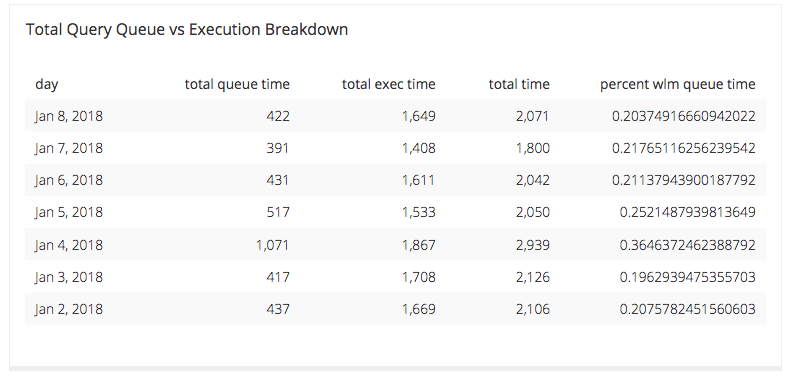
This queue can be used to cancel a user’s long-running query or add users to the database. Note: ensure to redact or obfuscate all confidential or identifying information (eg. A Redshift Query Queue is configured by default as follows: One Superuser Queue. task : integer : ID used to track a query through the workload manager. The query with the smallest position value runs next.

position : integer : Position of the query in the queue. Thus, when we limit the service class to a specific one, we can isolate that particular queue and leave out the other queues being created on this source as they do not necessarily impact each other here.News, articles and tools covering Amazon Web Services (AWS), including S3, EC2, SQS, RDS, DynamoDB, IAM, CloudFormation, AWS-CDK, Route 53, CloudFront, Lambda, VPC, Cloudwatch, Glacier and more. For a list of service class IDs, see WLM service class IDs. For consistency, this documentation uses the term queue to mean a user-accessible service class as well as a runtime queue.” From a user perspective, a user-accessible service class and a queue are functionally equivalent. Workload Management (WLM) reserves slots in a query queue equivalent to. “Amazon Redshift WLM creates query queues at runtime according to service classes, which define the configuration parameters for various types of queues, including internal system queues and user-accessible queues. query performance - Amazon Redshift complex query ptimization mean WebMay 8. We also limit the service class in the where clause and this is because Amazon Redshift creates WLM query queues based on the service class. Therefore, in the where clause of this query ,we need to add in a date filter to only include. We now want to break down this date span to a single day and array it over the hours of that particular day. In analyzing a particular source, keeping the analysis to around a week’s time is usually enough to make some diagnosis of a problem. Next, you need to assign a specific concurrency / memory configuration for each queue. In the where clause of the original query, the date span is narrowed to a seven day span and that is to keep the load on the STL limited. The first step is to define queues for your different workloads. service_class_start_time ) asc A Few Extra Notes service_class_start_time ):: DATE, date_part ( 'hour', w. You can use the new Amazon Redshift query monitoring rules feature to set metrics-based performance boundaries for workload management (WLM) queues. Queries that exceed the limits defined in your rules can either log (no action), hop (move to a different queue), or abort (kill the query). One, user group, has lots of meaning within Redshift like assigning user privileges and can only be changed by an admin as it is a database-wide configuration. You can use Redshifts built in Query Monitoring Rules ('QMR') to control queries according to a number of metrics such as returnrowcount, queryexecutiontime, and queryblocksread (among others). service_class_start_time ):: DATE, date_part ( 'hour', w. These are 2 properties that can be used in deciding query placement into a queue. Section 2: Modifying the WLM query queue configuration. service_class_start_time ):: DATE = '' GROUP BY ( w. Section 1: Understanding the default queue processing behavior. total_exec_time ):: FLOAT ) AS "Percent WLM Queue Time" FROM stl_wlm_query w WHERE w. As a reminder, Redshift’s Workload Manager allows you to define one or more queues for your clusters’ SQL queries, and to define the resources (e.g. total_exec_time ) / 1000000 AS "Total Time", ( SUM ( w. total_exec_time ) / 1000000 AS "Total Exec Time", SUM ( w. Each query is executed via one of the queues. WLM allows defining queues with specific memory allocation, concurrency limits and timeouts. total_queue_time ) / 1000000 AS "Total Queue Time", SUM ( w. Through WLM, it is possible to prioritise certain workloads and ensure the stability of processes. service_class_start_time ) AS "Day", SUM ( w.


 0 kommentar(er)
0 kommentar(er)
